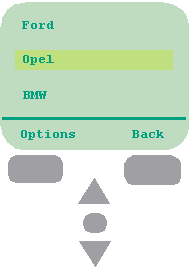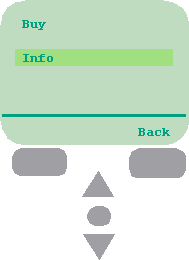 java.awt.Component
java.awt.Component
 java.awt.Container
java.awt.Container
 javax.swing.JComponent
javax.swing.JComponent
 javax.swing.JMenuBar
javax.swing.JMenuBar
|
JSR-209 (Final Release) | ||||||||||
| PREV CLASS NEXT CLASS | FRAMES NO FRAMES | ||||||||||
| SUMMARY: NESTED | FIELD | CONSTR | METHOD | DETAIL: FIELD | CONSTR | METHOD | ||||||||||
java.lang.Objectjava.awt.Component
java.awt.Container
javax.swing.JComponent
javax.swing.JMenuBar
An implementation of a menu bar. You add JMenu objects to the
menu bar to construct a menu. When the user selects a JMenu
object, its associated JPopupMenu is displayed, allowing the
user to select one of the JMenuItems on it.
For information and examples of using menu bars see How to Use Menus, a section in The Java Tutorial.
Warning:
Serialized objects of this class will not be compatible with
future Swing releases. The current serialization support is
appropriate for short term storage or RMI between applications running
the same version of Swing. As of 1.4, support for long term storage
of all JavaBeansTM
has been added to the java.beans package.
Please see java.beans.XMLEncoder.
A menubar is not a natural part of the use interface in many consumer devices,
instead soft keys are often used in these devices. Like MenuItem, the
soft keys are used to execute application specific actions.
The number of soft keys is limited, which means that the implementation may need
to change the menu hierarchy. For example, if the JMenuBar has three
top-level JMenus but the device has two soft keys, the implementation need to
cascade two menus onto one soft key.
The native UI style typically has a standard mapping of certain operations to
specific soft keys. For example, an action to get back in the interaction is
consistently assigned to the same soft key. To allow implementation to provide
similar adaptation to native look and feel practices the application should provide
semantic hints as client properties for JMenu and JMenuItem.
An application can define hints by calling JComponent.putClientProperty()
on the top-level JMenus in the JMenubar.
Note that in AGUI an empty JMenu can act like a JMenuItem.
(the reader may note similarities between the following sections and the MIDP
2.0 specification, these simalarities are intended) The following client properties
can be set:
MENU_TYPE
The application uses this property to specify the intent of this action. For example,
if the application specifies that the JMenuItem is of type
"BACK", and if the device has a standard of placing the "back"
operation on a certain soft-button, the implementation can follow the style
of the device by using the semantic information as a guide. The type of the
value of this property is String and the defined values for the property
MENU_TYPE are:
| Property Value |
Description |
BACK |
A navigation command that returns the user to
the logically previous screen. |
CANCEL |
A command that is a standard negative answer to
a dialog implemented by current screen. |
EXIT |
A command used for exiting from the application. |
HELP |
This command specifies a request for on-line help. |
ITEM |
With this command type the application can hint to the
implementation that the command is specific to the some selected item. |
OK |
A command that is a standard positive answer to a dialog
implemented by current screen |
SCREEN |
Specifies an application-defined command that pertains
to the current screen. |
STOP |
A command that will stop some currently running process,
operation, etc |
MENU_PRIORITYThe application uses the priority value to describe the importance of this command relative to other commands on the same screen. Priority values are integers, where a lower number indicates greater importance. The actual values are chosen by the application. A priority value of one might indicate the most important command, priority values of two, three, four, and so on indicate commands of lesser importance.
Typically, the implementation first chooses the placement of a command based on the type of command and then places similar commands based on a priority order. This could mean that the command with the highest priority is placed so that user can trigger it directly and that commands with lower priority are placed on a menu. It is not an error for there to be commands on the same screen with the same priorities and types. If this occurs, the implementation will choose the order in which they are displayed.
In a case where the device supports both menu bar and soft keys, the implementation
MAY choose to map the JMenuItems marked with the above properties to soft
keys while remaining menu hierarchy is put to the menu bar.
The algorithm in could be the following:
MENU_TYPE that match some of the
standard uses of the soft keys in the device. Such JMenus, at least
if empty, are mapped to such soft keys.JMenus directly under JMenubar
is greater to the number of remaining soft keys, the JMenuItems within
with higher priority (smallest value of MENU_PRIORITY) should get soft
keys first.JMenus in
the JMenubar are cascaded under a new menu with device-specific label.
The following text is provided as an example only. Implementations are not required to follow this behavior.
The application wishes to use three actions mapped to soft keys:
JMenuBar commands = new JMenuBar();
JMenuItem buy = new JMenu("Buy");
buy.putClientProperty("MENU_TYPE", "ITEM");
buy.putClientProperty("MENU_PRIORITY", new Integer(1));
commands.add(buy);
JMenuItem info = new JMenu("Info");
info.putClientProperty("MENU_TYPE", "ITEM");
info.putClientProperty("MENU_PRIORITY", new Integer(1));
commands.add(info);
JMenuItem back = new JMenu("Back");
back.putClientProperty("MENU_TYPE", "BACK");
back.putClientProperty("MENU_PRIORITY", new Integer(1));
commands.add(back);
myFrame.setJMenuBar(commands);
In a device with three soft keys the result could be equal to the example shown in MIDP specs:

If the device has only two soft buttons, the implementation has to build a menu hierarchy:

When user presses the left soft button, a menu with the two remaining Commands appears:

Note that the application did not deliver any hierarchy in the above example. It is possible to deliver such hierarchy as follows:
JMenuBar commands = new JMenuBar();
JMenu jm = new JMenu("Options");
jm.putClientProperty("MENU_TYPE", "ITEM");
jm.putClientProperty("MENU_PRIORITY", new Integer(1));
JMenuItem buy = new JMenuItem("Buy");
jm.add(buy);
JMenuItem info = new JMenuItem("Info");
jm.add(info);
jm.putClientProperty("MENU_PRIORITY", new Integer(1));
commands.add(jm);
JMenuItem back = new JMenu("Back");
back.putClientProperty("MENU_TYPE", "BACK");
back.putClientProperty("MENU_PRIORITY", new Integer(1));
commands.add(back);
JMenu,
JPopupMenu,
JMenuItem| Field Summary |
| Fields inherited from class javax.swing.JComponent |
listenerList, TOOL_TIP_TEXT_KEY, UNDEFINED_CONDITION, WHEN_ANCESTOR_OF_FOCUSED_COMPONENT, WHEN_FOCUSED, WHEN_IN_FOCUSED_WINDOW |
| Fields inherited from class java.awt.Component |
BOTTOM_ALIGNMENT, CENTER_ALIGNMENT, LEFT_ALIGNMENT, RIGHT_ALIGNMENT, TOP_ALIGNMENT |
| Fields inherited from interface java.awt.image.ImageObserver |
ABORT, ALLBITS, ERROR, FRAMEBITS, HEIGHT, PROPERTIES, SOMEBITS, WIDTH |
| Constructor Summary | |
JMenuBar()
Creates a new menu bar. |
|
| Method Summary | |
JMenu |
add(JMenu c)
Appends the specified menu to the end of the menu bar. |
void |
addNotify()
Overrides JComponent.addNotify to register this
menu bar with the current keyboard manager. |
java.awt.Component |
getComponent()
Implemented to be a MenuElement. |
int |
getComponentIndex(java.awt.Component c)
Returns the index of the specified component. |
JMenu |
getHelpMenu()
Gets the help menu for the menu bar. |
java.awt.Insets |
getMargin()
Returns the margin between the menubar's border and its menus. |
JMenu |
getMenu(int index)
Returns the menu at the specified position in the menu bar. |
int |
getMenuCount()
Returns the number of items in the menu bar. |
SingleSelectionModel |
getSelectionModel()
Returns the model object that handles single selections. |
MenuElement[] |
getSubElements()
Implemented to be a MenuElement -- returns the
menus in this menu bar. |
boolean |
isBorderPainted()
Returns true if the menu bars border should be painted. |
boolean |
isSelected()
Returns true if the menu bar currently has a component selected. |
void |
menuSelectionChanged(boolean isIncluded)
Implemented to be a MenuElemen |
void |
paint(java.awt.Graphics g)
Invoked by Swing to draw components. |
protected void |
paintBorder(java.awt.Graphics g)
Paints the menubar's border if BorderPainted
property is true. |
protected void |
paintComponent(java.awt.Graphics g)
Calls the UI delegate's paint method, if the UI delegate is non- null. |
void |
paintComponents(java.awt.Graphics g)
|
protected java.lang.String |
paramString()
Returns a string representation of this JMenuBar. |
protected void |
printBorder(java.awt.Graphics g)
Prints the component's border. |
protected void |
printComponent(java.awt.Graphics g)
This is invoked during a printing operation. |
void |
printComponents(java.awt.Graphics g)
|
protected boolean |
processKeyBinding(KeyStroke ks,
java.awt.event.KeyEvent e,
int condition,
boolean pressed)
Subclassed to check all the child menus. |
void |
processKeyEvent(java.awt.event.KeyEvent e,
MenuElement[] path,
MenuSelectionManager manager)
Implemented to be a MenuElement -- does nothing. |
void |
processMouseEvent(java.awt.event.MouseEvent event,
MenuElement[] path,
MenuSelectionManager manager)
Implemented to be a MenuElement -- does nothing. |
void |
removeNotify()
Overrides JComponent.removeNotify to unregister this
menu bar with the current keyboard manager. |
void |
setBorderPainted(boolean b)
Sets whether the border should be painted. |
void |
setHelpMenu(JMenu menu)
Sets the help menu that appears when the user selects the "help" option in the menu bar. |
void |
setMargin(java.awt.Insets m)
Sets the margin between the menubar's border and its menus. |
void |
setSelected(java.awt.Component sel)
Sets the currently selected component, producing a a change to the selection model. |
void |
setSelectionModel(SingleSelectionModel model)
Sets the model object to handle single selections. |
| Methods inherited from class java.awt.Container |
add, add, add, add, add, addContainerListener, addImpl, areFocusTraversalKeysSet, doLayout, findComponentAt, findComponentAt, getComponent, getComponentAt, getComponentAt, getComponentCount, getComponents, getContainerListeners, getFocusTraversalKeys, getFocusTraversalPolicy, getLayout, invalidate, isAncestorOf, isFocusCycleRoot, isFocusCycleRoot, isFocusTraversalPolicySet, list, list, processContainerEvent, processEvent, remove, remove, removeAll, removeContainerListener, setFocusCycleRoot, setFocusTraversalKeys, setFocusTraversalPolicy, setLayout, transferFocusBackward, transferFocusDownCycle, validate, validateTree |
| Methods inherited from class java.awt.Component |
addComponentListener, addFocusListener, addInputMethodListener, addKeyListener, addMouseListener, addMouseMotionListener, addMouseWheelListener, checkImage, checkImage, coalesceEvents, contains, createImage, createImage, createVolatileImage, createVolatileImage, disableEvents, dispatchEvent, enableEvents, enableInputMethods, getBackground, getBounds, getColorModel, getComponentListeners, getCursor, getFocusCycleRootAncestor, getFocusListeners, getFocusTraversalKeysEnabled, getFont, getFontMetrics, getForeground, getGraphicsConfiguration, getIgnoreRepaint, getInputContext, getInputMethodListeners, getInputMethodRequests, getKeyListeners, getLocale, getLocation, getLocationOnScreen, getMouseListeners, getMouseMotionListeners, getMouseWheelListeners, getName, getParent, getSize, getToolkit, getTreeLock, hasFocus, imageUpdate, isBackgroundSet, isCursorSet, isDisplayable, isEnabled, isFocusable, isFocusOwner, isFocusTraversable, isFontSet, isForegroundSet, isLightweight, isShowing, isValid, isVisible, list, list, list, paintAll, prepareImage, prepareImage, processComponentEvent, processFocusEvent, processInputMethodEvent, processMouseEvent, processMouseWheelEvent, removeComponentListener, removeFocusListener, removeInputMethodListener, removeKeyListener, removeMouseListener, removeMouseMotionListener, removeMouseWheelListener, repaint, repaint, repaint, setBounds, setBounds, setCursor, setFocusable, setFocusTraversalKeysEnabled, setIgnoreRepaint, setLocale, setLocation, setLocation, setName, setSize, setSize, toString, transferFocus, transferFocusUpCycle |
| Methods inherited from class java.lang.Object |
clone, equals, finalize, getClass, hashCode, notify, notifyAll, wait, wait, wait |
| Constructor Detail |
public JMenuBar()
| Method Detail |
public final void paint(java.awt.Graphics g)
JComponentpaint directly,
but should instead use the repaint method to
schedule the component for redrawing.
This method actually delegates the work of painting to three
protected methods: paintComponent,
paintBorder,
and paintChildren. They're called in the order
listed to ensure that children appear on top of component itself.
Generally speaking, the component and its children should not
paint in the insets area allocated to the border. Subclasses can
just override this method, as always.
paint in class JComponentg - the Graphics context in which to paintJComponent.paintBorder(java.awt.Graphics),
JComponent.paintChildren(java.awt.Graphics),
JComponent.getComponentGraphics(java.awt.Graphics),
JComponent.repaint(long, int, int, int, int)public SingleSelectionModel getSelectionModel()
SingleSelectionModel propertySingleSelectionModelpublic void setSelectionModel(SingleSelectionModel model)
model - the SingleSelectionModel to useSingleSelectionModelpublic JMenu add(JMenu c)
c - the JMenu component to add
public JMenu getMenu(int index)
index - an integer giving the position in the menu bar, where
0 is the first position
JMenu at that position, or null if
if there is no JMenu at that position (ie. if
it is a JMenuItem)public int getMenuCount()
public void setHelpMenu(JMenu menu)
menu - the JMenu that delivers help to the userpublic JMenu getHelpMenu()
JMenu that delivers help to the userpublic int getComponentIndex(java.awt.Component c)
c - the Component to find
public void setSelected(java.awt.Component sel)
sel - the Component to selectpublic boolean isSelected()
public boolean isBorderPainted()
public void setBorderPainted(boolean b)
b - if true and border property is not null,
the border is painted.isBorderPainted()protected final void paintBorder(java.awt.Graphics g)
BorderPainted
property is true.
paintBorder in class JComponentg - the Graphics context to use for paintingJComponent.paint(java.awt.Graphics),
JComponent.setBorder(javax.swing.border.Border)public void setMargin(java.awt.Insets m)
null will cause the menubar to
use the default margins.
m - an Insets object containing the margin valuesInsetspublic java.awt.Insets getMargin()
Insets object containing the margin valuesInsets
public void processMouseEvent(java.awt.event.MouseEvent event,
MenuElement[] path,
MenuSelectionManager manager)
MenuElement -- does nothing.
processMouseEvent in interface MenuElementgetSubElements()
public void processKeyEvent(java.awt.event.KeyEvent e,
MenuElement[] path,
MenuSelectionManager manager)
MenuElement -- does nothing.
processKeyEvent in interface MenuElementgetSubElements()public void menuSelectionChanged(boolean isIncluded)
MenuElement -- does nothing.
- Specified by:
menuSelectionChanged in interface MenuElement
- See Also:
getSubElements()
public MenuElement[] getSubElements()
MenuElement -- returns the
menus in this menu bar.
This is the reason for implementing the MenuElement
interface -- so that the menu bar can be treated the same as
other menu elements.
getSubElements in interface MenuElementpublic java.awt.Component getComponent()
MenuElement. Returns this object.
getComponent in interface MenuElementComponent (this)getSubElements()protected java.lang.String paramString()
JMenuBar.
This method
is intended to be used only for debugging purposes, and the
content and format of the returned string may vary between
implementations. The returned string may be empty but may not
be null.
paramString in class JComponentJMenuBar
protected boolean processKeyBinding(KeyStroke ks,
java.awt.event.KeyEvent e,
int condition,
boolean pressed)
processKeyBinding in class JComponentks - the KeyStroke queriede - the KeyEventcondition - one of the following values:
pressed - true if the key is pressed
public void addNotify()
JComponent.addNotify to register this
menu bar with the current keyboard manager.
addNotify in class JComponentJComponent.registerKeyboardAction(java.awt.event.ActionListener, java.lang.String, javax.swing.KeyStroke, int)public void removeNotify()
JComponent.removeNotify to unregister this
menu bar with the current keyboard manager.
removeNotify in class JComponentJComponent.registerKeyboardAction(java.awt.event.ActionListener, java.lang.String, javax.swing.KeyStroke, int)protected final void paintComponent(java.awt.Graphics g)
JComponentnull. We pass the delegate a copy of the
Graphics object to protect the rest of the
paint code from irrevocable changes
(for example, Graphics.translate).
paintComponent in class JComponentg - the Graphics object to protectJComponent.paint(java.awt.Graphics),
ComponentUIpublic final void paintComponents(java.awt.Graphics g)
protected final void printComponent(java.awt.Graphics g)
JComponentpaintComponent on the component.
printComponent in class JComponentg - the Graphics context in which to paintJComponent.print(java.awt.Graphics)protected final void printBorder(java.awt.Graphics g)
JComponentpaintBorder on the component.
printBorder in class JComponentg - the Graphics context in which to paintJComponent.print(java.awt.Graphics)public final void printComponents(java.awt.Graphics g)
|
JSR-209 (Final Release) | ||||||||||
| PREV CLASS NEXT CLASS | FRAMES NO FRAMES | ||||||||||
| SUMMARY: NESTED | FIELD | CONSTR | METHOD | DETAIL: FIELD | CONSTR | METHOD | ||||||||||